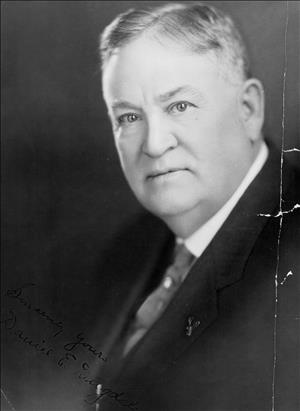Daniel E. Dugdale was born in Peoria, Illinois, on October 18, 1864, and soon learned to play the new game called baseball. He starred on some of the first professional teams as a catcher, but was lured to Seattle in 1898 by the Klondike Gold Rush. Instead of prospecting, he found his mother lode speculating in local real estate, which he got to survey while working as a grip man on Seattle cable cars. Dugdale put his new-found wealth to work by building some of Seattle's finest early baseball stadiums and managing some its most successful regional teams.
A Giant in His Field
Daniel Dugdale was a human leviathan who learned to love baseball in the sport's earliest days, and discovered the perfect position as catcher. Before arriving in Seattle in 1898, he starred on numerous Midwestern and East Coast teams. If you think players move around a lot today, consider his early career:
- 1884: Peoria, Illinois, and Keokuk, Iowa
- 1885: Hannibal Club, Leavenworth, Kansas, and Denver, Colorado
- 1886: Kansas City, Kansas, and Denver
- 1887: Rochester and Buffalo, New York
- 1888: Chicago, Illinois, and Spalding, Mississippi, (team relocated to Minneapolis)
- 1889-1891: Minneapolis, Minnesota
- 1891: Omaha, Nebraska
- 1892: St Paul, Minnesota; Fort Wayne, Indiana; and Green Bay, Wisconsin
- 1893: Chattanooga, Tennessee
- 1894: Washington, D.C.
- 1895: Peoria, Illinois (half owner and manager)
During his first year in Seattle, Dugdale helped to establish the Klondikers (later Rainmakers, Clamdiggers, and Chinooks) and the new Pacific Northwest League, which struggled for three years before achieving a stable operation in 1901. Between games, Dugdale continued working as a grip man on Seattle's early cable cars, and amassed his small fortune speculating in local real estate.
Who's on First?
In 1903, Dugdale's PNL Chinooks competed for players and fans with the "outlaw" Pacific Coast League's Seattle Siwashes. When the PCL was admitted to the National Association of Professional Baseball Leagues in 1904, Dugdale sold his Seattle interests and headed south to manage the Portland PCL franchise. The following year, he was instrumental in the re-formation of the Northwestern League. He was slated to manage the Bellingham franchise in the 1905 season, but deferred to Kirby Drennan before the season began.
Seattle dropped out of the PCL because of travel schedule complications created by the San Francisco earthquake of 1906. Dugdale returned to town and affiliated the Siwashes as a new Northwestern League franchise in 1907. That same year, he built his first namesake ballpark (also called Yesler Way Park) at 12th Avenue and Yesler Way. This field cradled the first golden era of Seattle baseball.
The Seattle Giants
The Siwashes became the Turks in 1909 and captured the Northwestern League pennant. In 1910, a fan contest produced a new name for the team, the Giants. In proportion to his team's new name, in 1914 Dugdale built the West Coast's first double-decked stadium in Rainier Valley.
Dugdale remained principal owner of the Giants through the 1918 season. His teams won five NWL pennants for Seattle and produced numerous future major leaguers, including the nucleus of the 1914 Boston Braves miracle squad.
A Fatal Tag
When Seattle reentered the Pacific Coast League in 1919, Dugdale again departed the local professional baseball scene, but his name graced the city's main stadium until an arsonist torched it on July 4, 1932. Brewer Emil Sick built his namesake ballpark on the same site five years later.
Daniel Dugdale remained involved with the state semi-pro baseball association as a local commissioner until he was run over and killed by a City Light truck while crossing a downtown street in 1934.

